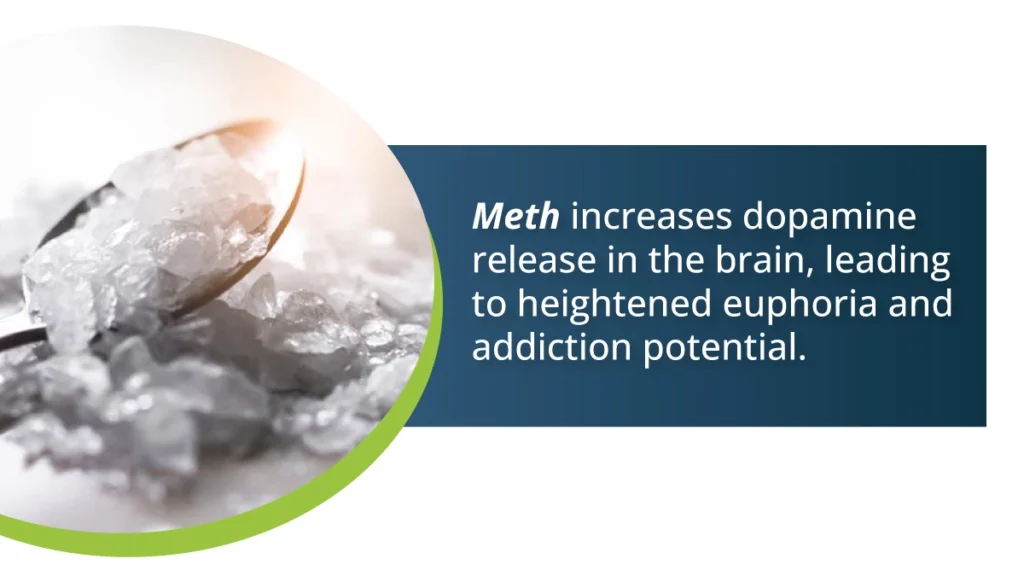Methamphetamine, or meth, is a powerful and highly addictive stimulant that affects the central nervous system (CNS). Understanding its chemical structure is essential for grasping how it impacts the brain and body. This article will provide a clear and concise explanation of meth’s structure, helping to demystify its complex nature.
Key Takeaways
Methamphetamine is a powerful and addictive stimulant affecting the central nervous system (CNS). Here is what the article entails:
- The structure of meth includes a benzene ring with a methyl group and an amino group on an ethyl side chain.
- Meth is synthesized using precursor chemicals through laboratory processes or illicitly in makeshift “meth labs.”
- Meth increases dopamine release in the brain, leading to heightened euphoria and addiction potential.
Contact The Haven Detox-Little Rock at (501) 271-3342 for evidence-based treatment to overcome drug addiction and regain control of your life.

What Is Methamphetamine
Methamphetamine, or meth, is a powerful stimulant drug that belongs to the amphetamine class. It affects the central nervous system (CNS), increasing alertness and physical activity while decreasing appetite. Methamphetamine can be taken orally, snorted, smoked, or injected, with each method altering the intensity and duration of its effects.
Chemically, meth increases the levels of dopamine in the brain, a neurotransmitter associated with pleasure and reward. This surge in dopamine produces a euphoric feeling, contributing to its high potential for abuse and addiction. Long-term use can lead to severe dental problems, extreme weight loss, skin sores, and anxiety.
In the United States, meth is classified as a Schedule II controlled substance, meaning it has accepted medical uses but a high potential for abuse that may lead to dependence. Production, distribution, and possession of methamphetamine are strictly regulated under federal and state laws due to its significant risks and harmful effects on individuals and communities.
Efforts to combat meth abuse include prevention programs, law enforcement initiatives targeting production and distribution networks, and treatment options for people struggling with meth addiction. Public awareness campaigns also aim to educate communities about the dangers and consequences of using methamphetamine as a recreational drug.
Chemical Structure Of Methamphetamine
Methamphetamine’s chemical structure plays a crucial role in its addictive properties, influencing how it interacts with the brain and body.
Molecular Formula
The molecular formula of meth, C10H15N, defines its composition—10 carbon atoms, 15 hydrogen atoms, and one nitrogen atom. This compact arrangement contributes to its potency and ability to affect the brain rapidly upon ingestion. The molecular structure allows meth to cross the blood-brain barrier swiftly, leading to heightened dopamine release—a neurotransmitter associated with pleasure and reward.
Structural Formula
Meth’s structural formula reveals a benzene ring with a methyl group (CH3) and an amino group (NH2) on an ethyl side chain. This configuration enhances its lipophilicity, allowing it to penetrate cell membranes easily and reach high concentrations in the brain. This efficient access to neural tissue amplifies its stimulant effects, contributing to the rapid onset and intense euphoria that users seek, reinforcing repeated use and addiction.
Isomerism
The isomeric forms of meth, (R)-methamphetamine and (S)-methamphetamine, exhibit varying degrees of potency and duration of action. The (S)-enantiomer, for instance, is more potent and longer-lasting, contributing significantly to meth’s addictive potential. Its ability to induce prolonged feelings of euphoria and heightened alertness makes it particularly prone to abuse, driving users to seek repeated and escalating doses.
Understanding these structural elements not only sheds light on meth’s addictive qualities but also informs strategies for treatment and prevention.
Physical Properties Of Methamphetamine
Methamphetamine possesses distinct physical properties that contribute to its identification and usage. Let’s explore these properties:
Physical State And Appearance
Methamphetamine typically presents itself as a crystalline powder or in crystalline chunks, ranging from clear to white. It is odorless and has a bitter taste. The crystals can vary in size and shape, resembling glass fragments or shiny rocks. This distinctive appearance contributes to its street names such as “crystal,” “crystal meth,” or “ice.”
Melting Point And Boiling Point
The melting point of meth is around 170°C (338°F), which is relatively low compared to many other substances. This characteristic makes it suitable for vaporization and smoking methods of ingestion. The boiling point of meth is approximately 215°C (419°F), indicating that it can withstand moderate heat without decomposing, which is important for its production and purification processes.
Solubility
Methamphetamine exhibits varying solubility depending on the solvent used. It is highly soluble in polar solvents such as water, alcohol, and acetone, while it is less soluble in non-polar solvents like benzene and petroleum ether. This property makes methamphetamine versatile in different forms of administration, including oral ingestion, injection, and vapor inhalation.
Understanding these properties is crucial in comprehending how the drug is manufactured, administered, and impacts the human body.
Synthesis And Production Of Methamphetamine
Methamphetamine is synthesized through various methods, both in laboratories and illicit settings, using specific chemical precursors. Let’s dig into these methods:
Laboratory Synthesis Methods
Methamphetamine can be synthesized in laboratories using relatively accessible chemicals and equipment. The process typically combines precursor chemicals like pseudoephedrine or ephedrine with red phosphorus and iodine reagents. This chemical reaction transforms the precursor into methamphetamine, which is then extracted and purified through various steps.
Illicit Production
Illicit production of methamphetamine often occurs in clandestine laboratories, where safety and legality are disregarded. This method, known as the “shake and bake” or “one-pot” method, involves mixing precursor chemicals in a single container. This simplified approach bypasses traditional laboratory equipment and poses significant risks due to the volatile nature of the chemicals involved.
Chemical Precursors
Key chemical precursors used in methamphetamine production include pseudoephedrine, ephedrine, and phenyl-2-propanone (P2P). These chemicals are often obtained from over-the-counter pills, chemical supply companies, or diverted from legitimate sources. Precursor control laws aim to restrict access to these chemicals to curb illicit production.
Understanding the synthesis and production pathways of methamphetamine underscores the challenges in combating its illicit trade and addiction.
Biological Interaction Of Methamphetamine
Methamphetamine exerts its effects through intricate biological interactions, influencing both short-term reactions and long-term neurological changes.
Mechanism Of Action
Methamphetamine acts primarily by increasing the release and blocking the reuptake of neurotransmitters, particularly dopamine, norepinephrine, and serotonin. It enters nerve terminals through transporters for these neurotransmitters and disrupts their normal cycling, leading to an accumulation in the synaptic cleft. This accumulation results in prolonged stimulation of postsynaptic receptors, contributing to the drug’s euphoric effects.
Neurotransmitter Interaction
Dopamine is a key player affected by meth, contributing to the drug’s rewarding and reinforcing effects. Increased dopamine levels produce feelings of euphoria and energy. Norepinephrine, another neurotransmitter influenced by methamphetamine, contributes to increased heart rate, blood pressure, and arousal. Serotonin levels are also affected, which can lead to mood elevation but may contribute to neurotoxic effects over time.
Short-Term And Long-Term Effects
Short-term effects of methamphetamine include increased wakefulness and physical activity, decreased appetite, rapid breathing, and increased body temperature. Users may experience euphoria, increased libido, and heightened attention. However, these effects are often followed by negative consequences such as irritability, anxiety, aggression, paranoia, and insomnia.
Long-term use of methamphetamine can lead to severe health issues, including addiction, weight loss, severe dental problems (“meth mouth”), skin sores, and cognitive impairments. Chronic methamphetamine use can also lead to structural and functional changes in the brain, impacting decision-making, memory, and emotional regulation.
Understanding how meth interacts with neurotransmitter systems provides insights into its addictive potential and the wide-ranging effects it can have.
Analytical Techniques For Identification
Several analytical methods are employed to detect and confirm the presence of methamphetamine in various samples. Let’s explore the common ones:
Spectroscopy
Spectroscopy techniques like Nuclear Magnetic Resonance (NMR), Infrared Spectroscopy (IR), and Mass Spectrometry (MS) are pivotal in methamphetamine identification. NMR provides detailed information about the molecular structure, IR detects functional groups, and MS determines the molecular weight and fragmentation patterns. Together, these methods create a fingerprint for identifying methamphetamine in samples.
Chromatography
High-Performance Liquid Chromatography (HPLC) and Gas Chromatography (GC) are indispensable for separating and analyzing methamphetamine components. HPLC uses solvents to move substances through a column for precise separation, while GC vaporizes samples for separation based on boiling points. Both methods detect and quantify methamphetamine in complex mixtures with high sensitivity.
Other Identification Methods
Additional methods for meth identification include color tests, which produce characteristic color changes when specific chemical reactions occur with methamphetamine. These tests are rapid and can provide preliminary identification in field settings. Additionally, crystallography can determine the precise three-dimensional arrangement of atoms in a meth crystal, aiding in forensic investigations.
These techniques not only confirm the presence of methamphetamine but also provide insights into its purity, composition, and potential sources.
Frequently Asked Questions (FAQ)
What type of amine does methamphetamine contain?
Methamphetamine contains a type of amine known as a secondary amine. In chemistry, amines are organic compounds derived from ammonia, where organic groups replace one or more hydrogen atoms. A secondary amine specifically has two organic groups attached to the nitrogen atom.
In methamphetamine, the nitrogen atom is bonded to two methyl groups (-CH3), making it a secondary amine. This structural arrangement is important because it affects the chemical properties and biological effects of methamphetamine, including its stimulant and psychoactive characteristics.
What is the functional group of methamphetamine?
Meth contains an amine functional group, which is a nitrogen atom bonded to two hydrogen atoms. This amine group is essential to the chemical structure of meth, influencing its biological effects. Amines are commonly found in organic molecules and are characterized by their nitrogen-hydrogen bonds.
In meth, this amine group plays a key role in interactions with receptors in the brain, affecting neurotransmitter levels and contributing to its stimulant properties. Understanding the presence and function of the amine group helps comprehend how meth interacts with the body and brain.
What chemicals are in meth?
Methamphetamine contains chemicals such as pseudoephedrine or ephedrine, which are used as starting materials in its production. These chemicals undergo a series of chemical reactions, often involving solvents like acetone and acids like hydrochloric acid or sulfuric acid, to form meth.
The final product also includes other by-products and impurities from the manufacturing process. Meth is a powerful stimulant drug, altering mood, energy levels, and perception. Its production and use pose significant health risks and legal consequences due to its highly addictive nature and harmful effects.
Seek Help At The Haven Detox-Little Rock
Struggling with methamphetamine addiction can feel like being lost in a storm, but you are not alone. At The Haven Detox-Little Rock, we are here to guide you to calmer waters.
Starts with our compassionate medical detox program, carefully designed to safely eliminate toxins from your body and prepare you for comprehensive treatment. Once detox is complete, our intensive 24/7 residential rehab program awaits, offering evidence-based therapies, prescription drugs, NAD IV therapy, holistic approaches, and more. These tools are tailored to empower you to overcome addiction and rebuild a healthy life.
Don’t wait to take the initial step towards a healthier future. Contact us now at (501) 271-3342 to learn more about how our team of experts can aid you on your path to recovery.




